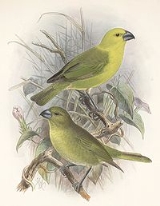
Lesser Koa Finch
Encyclopedia
The Lesser Koa Finch is an extinct species of finch
in the Hawaiian honeycreeper
subfamily
, Drepanididae.
, other than the fact that the former were slightly darker in color. The juveniles were somewhat mottled on the belly, similar to the females. As its name suggests, the species as a whole was smaller than the other scientifically described Koa-Finches, measuring on average only five inches in length.
plant from which it got nectar and fruit (and for which it was named). The Koa also provided refuge for small flocks of the finch as it avoided people and the noon high sun. It was seen congregating with its larger relative, the Greater-Koa Finch. Several specimens were collected and sent to London, Cambridge, New York, Philadelphia, and Berlin.
It is also noticed that there was only two confirmed sighting of the birds, when the first and last specimens were shot. In all, there were eight specimens that were collected, all of them from in trees that were used by the Greater Koa Finch. There were several other related species living at its time including one from Oahu, one from Maui and one living in Kona. It has been confused with a House Finch and many novice bird watchers claim false sightings. It was also confused with the O’u, which was still common on Hawaii and Kauai until the latter's recent disappearance.
Finch
The true finches are passerine birds in the family Fringillidae. They are predominantly seed-eating songbirds. Most are native to the Northern Hemisphere, but one subfamily is endemic to the Neotropics, one to the Hawaiian Islands, and one subfamily – monotypic at genus level – is found...
in the Hawaiian honeycreeper
Hawaiian honeycreeper
Hawaiian honeycreepers are small, passerine birds endemic to Hawaii. Some authorities still categorize this group as a family Drepanididae, but in recent years, most authorities consider them a subfamily, Drepanidinae, of Fringillidae, the finch family...
subfamily
Family (biology)
In biological classification, family is* a taxonomic rank. Other well-known ranks are life, domain, kingdom, phylum, class, order, genus, and species, with family fitting between order and genus. As for the other well-known ranks, there is the option of an immediately lower rank, indicated by the...
, Drepanididae.
Description
The only specimens of the Lesser Koa Finch ever caught were a family group with members of different ages and genders, ideal for study. The males were apparently golden-yellow with olive green on the breast and belly. The females were almost indistinguishable from the species' larger relative, the Greater Koa FinchGreater Koa Finch
The Greater Koa Finch was a species of finch in the Fringillidae family. It was found only in the Hawaiian Islands. It has been extinct since the late 19th century.- Description :...
, other than the fact that the former were slightly darker in color. The juveniles were somewhat mottled on the belly, similar to the females. As its name suggests, the species as a whole was smaller than the other scientifically described Koa-Finches, measuring on average only five inches in length.
Behaviour
Its life cycle and feeding habits apparently centered around the KoaKoa
Acacia koa is a species of flowering tree in the pea family, Fabaceae. It is endemic to the Hawaiian Islands, where it is the second most common tree. The highest populations are on Hawaii, Maui and Oahu...
plant from which it got nectar and fruit (and for which it was named). The Koa also provided refuge for small flocks of the finch as it avoided people and the noon high sun. It was seen congregating with its larger relative, the Greater-Koa Finch. Several specimens were collected and sent to London, Cambridge, New York, Philadelphia, and Berlin.
Extinction
The bird appeared to have always had a small population. When people brought cattle and created ranches in the Koa forests, the younger Koa trees began to be trampled by the cows. The cows also stripped the leaves off the trees at a fast rate than the leaves normally fell. The older trees were too tall to be defoliated, but their roots were kicked and pulled out, causing them to grow weak and eventually die. With the loss of the native Koa trees the last birds began to die off. Finally, the bird was never seen after the year 1891.It is also noticed that there was only two confirmed sighting of the birds, when the first and last specimens were shot. In all, there were eight specimens that were collected, all of them from in trees that were used by the Greater Koa Finch. There were several other related species living at its time including one from Oahu, one from Maui and one living in Kona. It has been confused with a House Finch and many novice bird watchers claim false sightings. It was also confused with the O’u, which was still common on Hawaii and Kauai until the latter's recent disappearance.
Source
- BirdLife International 2004. Rhodacanthis flaviceps. 2006 IUCN Red List of Threatened Species. Downloaded on 10 July 2007.
- Bryson, Bill. A Short History of Nearly Everything. 1st ed. 1 vol. New York, NY: Broadway Books, 2004. 476. Print.
- Munro, George C. Birds of Hawaii. ISBN 0804800634

